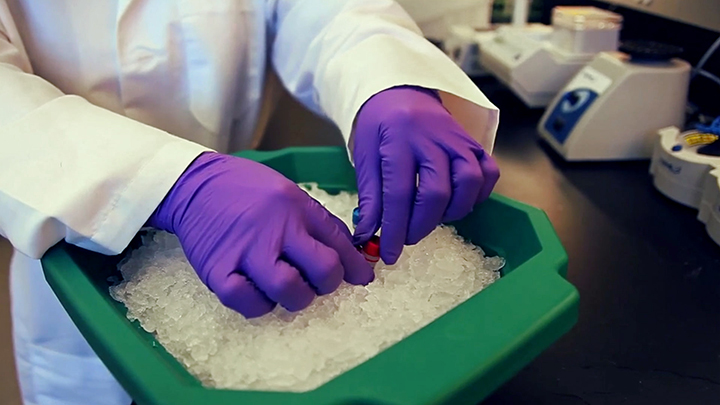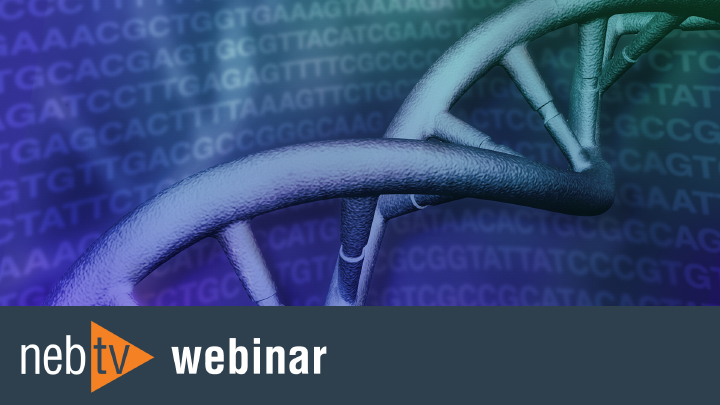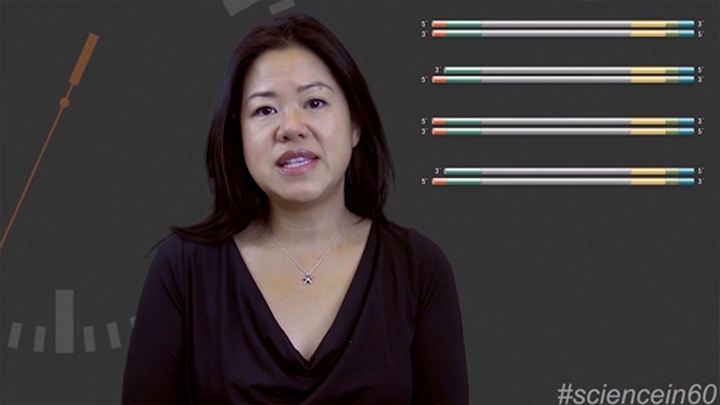NEB® TV Ep. 4 – Next Generation Sequencing
Script
NEB TV, what's trending in Science.
Deana Martin:
Welcome to NEB TV. Today I'm joined by Eileen Dimalanta, who is a group leader for the NEBNext product development team. Hey Eileen.
Eileen Dimalanta,PhD:
Hey Deana.
Deana Martin:
And today we are talking about Next Generation Sequencing.
Eileen Dimalanta,PhD:
First I'll talk about library preparation, and I'll be trying to do that in 60 seconds. Next, we'll meet members of the product development team to talk about a new NEBNext product that offer several advantages over other methods. Lastly we'll hear from Kevin McKernan, the CSO of Courtagen and founder of Medicinal Genomics. He'll give his perspective on the future of Next Generation Sequencing.
Deana Martin:
Great, let's get started.
Eileen Dimalanta, PhD:
In order to sequence a sample in using Next Generation Sequencing, you need to make a library. That library consist of fragments of the DNA you are interested in, attached to short adapters at each end required for the downstream sequencing process. For library prep for Illumina, the first step is to fragment the DNA, repair the ends by filling in or chewing back overhangs, and phosphorylate the five prime ends.
dA-tailing them adds a 'A' to the three prime ends of the blunted fragments and adapters with a T-overhang are then ligated.
The final step is PCR amplification, which increases the amount of library and enriches the fragments that have an adapter ligated to both ends. To produce high quality sequence data, you need a high quality library that has equal representation of every part of the original DNA without any bias. A high quality library will result in sequence data with uniform GC coverage, a low percentage of duplicates, and chimeras and a high percentage of reads that map to the reference sequence with no dropouts.
Deana Martin:
I am here with Lynne Apone and Ping Liu, two scientists who lead the development of the NEBNext Ultra II products. Hi ladies.
Lynne Apone,PhD:
Hi.
Ping Liu,PhD:
Hi Deana.
Deana Martin:
So, what were your goals for developing the new NEBNext Ultra II product line?
Ping Liu,PhD:
So we get a lot of requests from the customer for the past one or two years saying that they have very limited sample and then they just have a difficult time making a library so we decided we would just going to develop a new kit. We get a very high quality of library from as low as 500 picograms of human genomic DNA, but if you have a low-complexity genome then you can go much lower than that.
Lynne Apone,PhD:
I think it just allows researchers to use more samples. So those samples are, like you say, they just couldn't make a library, they now can make libraries and ChIP-seq is one of those areas, those unique protocols where often there is not much library and so this allows those researchers to use samples that they just couldn't use before.
Most people think of it as occurring in PCR where specific sequences are amplified in preference to others. And so what happens is you can end up with a library that doesn't completely represent your starting input. And so we spent a lot of effort limiting that bias so that the final product mimics your input.
One of the biggest challenges I think we find in next gen sequencing is that it's changing, what people look at is changing, the metrics are changing constantly. So what we want to do is when we are evaluating our kits and our products is to try to understand how our customers are using them and evaluating them. So, trying to understand the metrics we need to use to evaluate the kits properly, whether it is sequence coverage, uniformity of coverage, duplication rates, chimeras, we need best how our customers are looking at the products and using them.
Lynne Apone,PhD:
Yeah, I think low input, definitely, as low as we can go. At one point I think I made libraries from 5 picograms of human DNA. So now we are starting to open the door, really, to new technologies and new uses for next gen sequencing in diagnostics and treatment, in those areas that are so exciting.
Deana Martin:
Well thanks so much for joining us today and we hope that you will be back soon.
Ping Liu,PhD:
Thank you
Lynne Apone,PhD:
Thank you
Keven McKernan:
Hi, I am Keven McKernan from Courtagen Life Sciences. We do a lot of clinical sequencing work in pediatric neurology.
Currently there are a lot of short-read next gen sequencing going on, it is great for sequencing small gene panels to mid-size exomes and even whole Genome sequencing. I think we are seeing most traction in the clinic and sort of the thousand gene area with exomes coming on board, but there is also a lot of unmet needs.
We need to be able to pick up chromosomal microarray data in sequencing and I think that's going to happen in the next year, perhaps a year of two after that I think we will start to see some single molecule sequencing techniques, perhaps capture the triplet repeats, if we can do that on next gen platforms it would be even better, but we suspect some of those triplet repeats being very long in nature and may require some single molecule sequencing that can capture those. But we are excited because we can see many of these techniques all unifying on a single platform.
Deana Martin:
Eileen, thanks for joining us today.
Eileen Dimalanta,PhD:
You are very welcome.
Deana Martin:
And thank you for watching. If you have any suggestions for future episodes, please let us know.
Related Videos
-

12 Quick Tips for NGS Library Preparation -

How Library Preparation Affects Sequencing Accuracy -

Library prep for NGS

